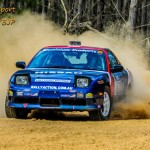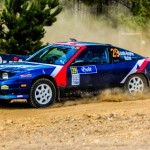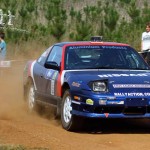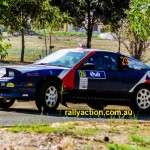2013 Quit Forest Rally

The Quit Forest Rally (QFR) is the biggest rally in WA these days. As the Forest is a round of the national championship, it is run over two days and has approx 220km of competitive stages. Getting a rally team and a rallycar through a big event is always a challenge, especially when you run a new car. It’s not the ideal way to start a championship with the biggest event first, however that is the way the calendar stacks up. A couple of weeks before the Forest we’d taken the 180SX to a club Khanacross to give it a shakedown. The car ran well without any major problems. Our only items to fix were a loose mud flap and the LH headlight rod had fallen off, causing the light to partially close instead of staying up.
In the lead up to the Forest, we went right through the car, checked everything and found a leaking rear brake calliper. We replaced the calliper and re-bled the brakes. The headlight rod was also sorted and we completed the plumb in and wiring for an intercooler sprayer bottle. With only the factory intercooler to keep charge air temp down, any extra cooling, no matter how minor is a worthwhile fitment.
We also sorted all the spares, and strengthened the suspension arms by welding in gussets and small plates. 2013 was planned to be a year of development to see what would break and what work we’d have to do to make the car reliable. Suspension arms seemed a likely point of weakness so we started there first. A spare turbo also found its way into the package along with several sets of wheels and tyres.
The last major item on the list was to pass pre-event scrutiny. We’d gone through the rule book and made sure we had everything sorted. Bringing a new car to the championship often results in a swarm of scrutineers looking at the car. As it turned out, scrutiny for the Forest was quite rudimentary. There were several new cars mixed in with the regulars and no car was intensely inspected.
 In the next couple of days we headed south to Busselton all loaded up to tackle the rally. Thankfully we don’t have to take any fuel down any more as the local service station supplies 98 octane fuel. Taking 200L drums of fuel with you to a rally can take up a lot of space and add plenty of extra weight to the load. On the Friday morning, the driver & navigator went out and completed recce (pace notes) whilst we added stickers, adjusted harnesses and fitted the organiser supplied GPS tracking system. The car was ready to start the rally by mid Friday afternoon.
In the next couple of days we headed south to Busselton all loaded up to tackle the rally. Thankfully we don’t have to take any fuel down any more as the local service station supplies 98 octane fuel. Taking 200L drums of fuel with you to a rally can take up a lot of space and add plenty of extra weight to the load. On the Friday morning, the driver & navigator went out and completed recce (pace notes) whilst we added stickers, adjusted harnesses and fitted the organiser supplied GPS tracking system. The car was ready to start the rally by mid Friday afternoon.
The start of the QFR is a bit like a circus. On the Friday and Saturday nights of the event, the cars run around a 2km tarmac special stage on the Busselton foreshore. Spectators can see the cars, listen to commentary and buy an expensive hamburger, however no one is going to win the rally there. The 180SX performed as it should with the driver taking it easy on the tarmac and “dialling in” to the new car, the real test would be out in the forests the next day.
Saturday morning dawned and we headed up to Nannup, 50km south of Busselton to set up the service area and ready ourselves for the first service. The rally car came in, we checked fluids, swapped the tyres to a new set of med-soft compound gravel and sent the car out for the first group of stages.
group of stages.
At the next service, the driver was complaining about the brakes. The fronts were locking far too easily (even with full rear brake bias settings) and to counteract the problem he had to brake well back from the corners. We were losing a lot of time. We instantly knew that the standard rear brakes were not large enough for the job. It was a discussion we’d had on several occasions during the build and due to budget restraints we’d left the brakes as is Our quick fix was to disconnect the brake booster to provide more pedal feel and see if that would help. We also softened the bump on the rear dampers to provide better traction.
The next group of stages were much better and the times improved dramatically. The firmer brake pedal and softer rear end was providing more confidence and better traction. We were now feeling that the theoretical setup for the car was working. As the day continued our placing steadily increased. We also changed to hard compound tyres for the rest of the day as the temp warmed up, knowing the stages were loose and gravelly in a few places. Two of our main rival teams in 2WD had trouble during Saturday which also helped our cause. By the final stage Saturday afternoon, we’d secured the state 2WD win for heat 1 of the rally. We were surprised and very happy with the results.
Saturday evening was more or less a repeat of Friday with 4 continuous laps around the tarmac. The car again ran fine and went into overnight parc ferme without trouble.
Sunday morning it was back to Nannup for the forest stages of heat 2 of the rally. The plan was to continue the pace and stay out of trouble. It wasn’t to be though. By the second group of stages we received a text message to say the 180SX had clutch trouble. The car was still going, however the clutch wasn’t disengaging and we had to wait for the 180SX come back to service to have a look at it. If it was a hydraulic problem like a slave or master cylinder, no dramas, we had the time and spares. Anything more serious and we may not have time to fix it.
 When the car arrived back in service we didn’t hold much hope. The rod and the innards from the slave cylinder were gone and the clutch fork was also adrift inside the bell housing. It was going to be a gearbox out job and with only 20 minutes of service and 30 minutes of late time to stay in the rally, the pressure was on. Up until that point, we’d never had the box out of the 180SX. In ideal circumstances, the car would have been stripped completely during the build and parts like the clutch would have been inspected and most likely replaced. Now on axle stands laying on our backs under the rally car, we were attempting in under an hour what we’d normally do on a hoist in the workshop in 3-4 hours.
When the car arrived back in service we didn’t hold much hope. The rod and the innards from the slave cylinder were gone and the clutch fork was also adrift inside the bell housing. It was going to be a gearbox out job and with only 20 minutes of service and 30 minutes of late time to stay in the rally, the pressure was on. Up until that point, we’d never had the box out of the 180SX. In ideal circumstances, the car would have been stripped completely during the build and parts like the clutch would have been inspected and most likely replaced. Now on axle stands laying on our backs under the rally car, we were attempting in under an hour what we’d normally do on a hoist in the workshop in 3-4 hours.
We soon found that the SR20 has 50% too many bolts holding the engine to the transmission. Usually between 4 and 10 bolts hold most engines and gearboxes together. The 180SX has about 16 and many were in hard to reach places like behind the red hot turbo. It took nearly an hour just to get the bolts out and some were bloody hot. We had no choice but to withdraw from the rally, there just wasn’t enough time to fix the car. Also as we drained the oil from the gearbox, there was a great deal of metal coming out and recognisable pieces of synchro too. Without the clutch, the driver had been forcing the car into gears and the damage had been done to the transmission. We got the gearbox out of the car and inspected the back of the engine. The clutch had completely failed. Fingers were broken off, springs had come out and jammed between the drive & pressure plates and worst of all, the alloy nose on the front of the gearbox had broken off  and melted away with friction! That the car had even driven back to service under its own power was amazing.
and melted away with friction! That the car had even driven back to service under its own power was amazing.
How much of the damage to the clutch was pre-existing we don’t know. The car had been drifted and driven very hard before we built it into a rally car. Rallying the car had just finished it off. One of those things…
It was a little disappointing having to withdraw on the second day however there were some upsides. First, we’d won 2WD on the first day and that was a great effort. The 180SX had performed well and had also home un-damaged. A clutch and gearbox replacement would see the car ready for the next rally in 4 weeks time and we knew we could address the brake issue and spend some time on development.
More build articles here
To find out more about how we can help build and/or maintain a rally or competition car for you, visit: www.rallyaction.com.au